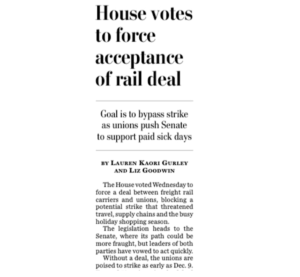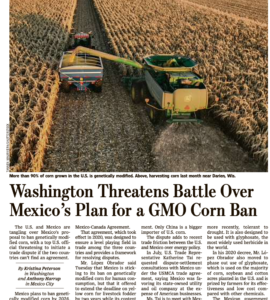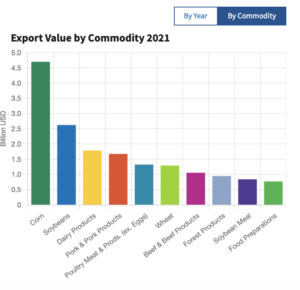Congress has quickly engaged in putting together potential aid packages for farmers that would more than double the Trump administration's $12 billion under the Farmer Bridge Assistance (FBA) Program.
House Moves on Rail Dispute, as U.S. and Mexico “Tangle” on GMO Corn
Lauren Kaori Gurley and Liz Goodwin reported on the front page of today’s Washington Post that, “The House voted Wednesday to force a deal between freight rail carriers and unions, blocking a potential strike that threatened travel, supply chains and the busy holiday shopping season.
“The legislation heads to the Senate, where its path could be more fraught, but leaders of both parties have vowed to act quickly.
“Without a deal, the unions are poised to strike as early as Dec. 9. Four of 12 unions involved had voted down a contract, brokered by the White House, that lacked paid sick days or changes to an attendance policy that rail workers say is punitive. A shutdown of the nation’s railway systems could cost the economy as much as $2 billion a day, according to the rail carriers trade group.”

Today’s article noted that, “The House voted 290-137, with bipartisan support, on the bill that would force the rail deal that was brokered by the White House. But the chamber also narrowly approved a separate version of the rail deal, 221-207, to give rail workers seven paid sick days, a move that liberal Democrats in the House, as well as Sen. Bernie Sanders (I-Vt.), have pushed for.”
“Both bills head to the Senate, but timing on the votes there is uncertain,” the Post article said.
Associated Press writer Josh Funk reported on the front page of today’s Los Angeles Times that, “‘Without the certainty of a final vote to avoid a shutdown this week, railroads will begin to halt the movement of critical materials like chemicals to clean our drinking water as soon as this weekend,’ [President] Biden said. ‘Let me say that again: Without action this week, disruptions to our auto supply chains, our ability to move food to tables, and our ability to remove hazardous waste from gasoline refineries will begin.'”

“The focus now turns to the Senate, where the timing for a vote is unclear. Labor Secretary Marty Walsh and Transportation Secretary Pete Buttigieg will meet with Democratic senators Thursday to discuss the rail negotiations,” Funk said.
Meanwhile, Wall Street Journal writers Kristina Peterson and Anthony Harrup reported in today’s paper that, “The U.S. and Mexico are tangling over Mexico’s proposal to ban genetically modified corn, with a top U.S. official threatening to initiate a trade dispute if the two countries can’t find an agreement.
“Mexico plans to ban genetically modified corn by 2024, adding another flashpoint to the two countries’ tensions over trade. More than 90% of corn grown in the U.S. is genetically modified, according to the National Corn Growers Association.”
Today’s article stated that, “[Mexican President Andrés Manuel López Obrador] said Tuesday that Mexico is sticking to its ban on genetically modified corn for human consumption, but that it offered to extend the deadline on yellow corn for livestock fodder by two years while its content is being studied.
“‘We’re self-sufficient in white corn and we’re not going to allow imports of yellow corn for human consumption,’ he said. The ban applies to both yellow and white corn. Mexico imports much of its yellow corn to feed livestock.

“Both [Sec. of Agriculture Tom Vilsack] and [Pres.] López Obrador said they were still hoping to reach an agreement over genetically modified corn.”
The Journal article added that, “[U.S. Trade Representative Katherine Tai] is scheduled to meet with Mexican Economy Minister Raquel Buenrostro on Thursday in Washington, according to U.S. and Mexican officials. The two are expected to discuss both the rifts over genetically modified corn and Mexico’s nationalist energy policies, a Mexican official said.”
And yesterday, The Wall Street Journal editorial board opined Online that, “Banning U.S. corn would raise meat prices in Mexico and is unlikely ahead of the country’s 2024 elections.”

Meanwhile, Bloomberg News reported earlier this week that, “Plunging temperatures could be the next flashpoint for China’s commodities markets, after the coldest weather in the northwest in over a decade killed workers and livestock.
“Seven road workers died near the city of Altay at the weekend after blizzards struck the Xinjiang region, according to the Xinhua News Agency. Hundreds of sheep and cattle were also reported dead or missing in China’s main pastoral area, as well as over 200 livestock fatalities in neighboring Mongolia.”
The Bloomberg article added that, “The livestock losses in the north were caused in part by Covid rules that restricted the timely movement of animals and disrupted the supply of feed. Herds of sheep and cattle were frozen in snow as they foraged for food or because herders couldn’t get them to their winter quarters in time, according to reports.”
Also with respect to China, Reuters writer Naveen Thukral reported today that, “China is softening its tone on the severity of COVID-19 and easing some coronavirus restrictions even as its daily case toll hovers near record highs, after anger over the world’s toughest curbs fuelled protests across the country.
“Chinese cities of Guangzhou and Chongqing announced an easing of COVID curbs on Wednesday, a day after demonstrators in southern Guangzhou clashed with police amid a string of protests against the world’s toughest coronavirus restrictions.”
Elsewhere, Reuters writer Maximilian Heath reported yesterday that, “Argentine farmers nearly doubled soybean sales on Tuesday from the day before, the major Buenos Aires grains exchange said, after a preferential exchange rate went into effect for exports of the cash crop….The new policy, which allows farmers to settle sales for 230 pesos per dollar, nearly 40% above the official rate, boosted sales from the 78,303 tonnes sold Friday, the exchange said.”
And Reuters writer Olga Popova reported today that, “State controlled trader United Grain Company (UGC) expects Russia to export 53-54 million tonnes of grain in the 2022/23 season, its deputy head Ksenia Bolomatova told an agriculture conference on Thursday.
“The country’s agriculture ministry in September forecast grain exports of between 50-60 million tonnes in the 2022/23 season.”
Also today, Evan Halper reported in today’s Washington Post that, “Filling up is now as cheap as it was in February, just before Russia’s invasion of Ukraine touched off a global energy crisis. AAA reported the average nationwide price of a gallon of regular Wednesday was $3.50, and gas price tracking company GasBuddy projected it could drop below $3 by Christmas.”





